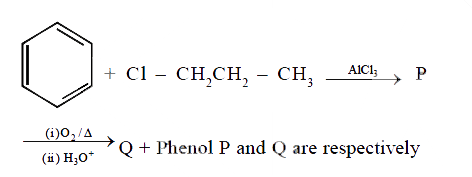The type of H-bonding present in ortho nitro phenol and p-nitro phenol are respectively :
inter molecular H-bonding and intra molecular H-bonding.
intra molecular H-bonding and inter molecular H-bonding
intra molecular H-bonding and no H-bonding.
intra molecular H-bonding and intra molecular H-bonding.
The correct Answer is:b
Similar Questions
Knowledge Check
Assertion : Ortho nitro phenol is more acidic than meta nitro phenol
Reason : Ortho nitro phenol has more –I effect than meta nitro phenolAIf both assertion and reason are true and reason is the correct explanation of assertion.BIf both assertion and reason are true but reason is not the correct explanation of assertion.CIf assertion is true but reason is false.DIf both assertion and reason are false.The Type of isomerism present in pentaammine nitro chromium(III) perchlorate is .
AOpticalBLinkageCHydrateDPolymerisation
The type of isomerism present in nitro pentaamine-chromium(III)chloride is:
View SolutionAssertion : Ortho nitro phenol is more acidic than meta nitro phenol
Reason : Ortho nitro phenol has more –I effect than meta nitro phenol
View SolutionO-Nitro phenol is less acidic than P- nitro phenol. Give reason
View SolutionThe Type of isomerism present in pentaammine nitro chromium(III) perchlorate is .
View Solutionp - Nitro phenol is more acidic than phenol. Explain.
View SolutionAnswer the following :
(i) Phenol is more acidic than ethyl alcohol.
(ii) Phenol is an acid but does not react with NaHCO3.
(iii) Although phenoxide ion has more number of resonating structures than benzoate ino, benzoic acid is stronger acid than phenol . Why ?
(iv) Name the phenol with molecular formula C7H8O which on treatment with Br2 water readily gives a precipitate of C7h5OBr3.
(v) Unlike phenol, 2,4-dinitrophenol and 2,4,6-trinitrophenol are soluble in aqueous sodium carbonate solution.
(vi) Phenol has higher boiling than toluence. although they have almost the same molecular mass.
(vii)Ortho nitro phenol is steam volatile while para nitro phenol is not.
(viii) In Kolbe's reaction, instead of phenol, phenoxide ion is treated with CO2.
(ix) Nucleophilic substitution reactions are not very common in phenols.
(x) The dipole moment of phenol is smaller than that of methanol.
View Solution

 Phenol P and Q are respectively
Phenol P and Q are respectively